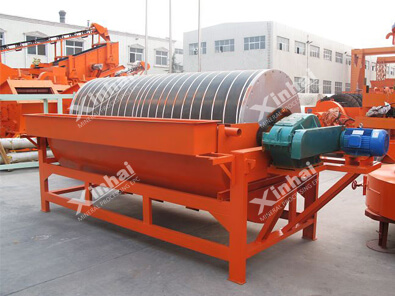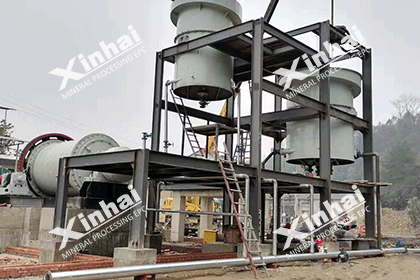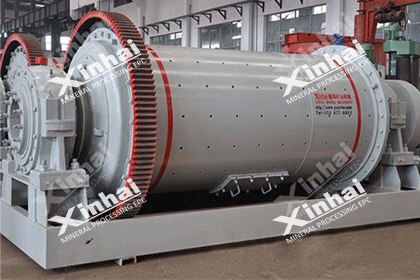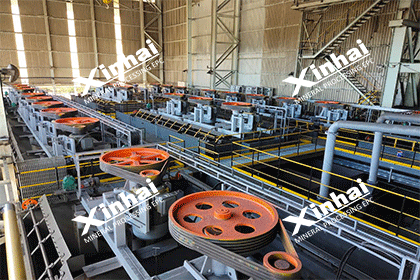Beneficiation Methods of 5 Kinds of Iron Ore
 Essow
Essow
 Jun 28, 2022
Jun 28, 2022
 2364
2364
If you want to know more details about equipment, solutions, etc, please click the button below for free consultation, or leave your requirements!
Iron is the most commonly used metal, containing about 5.8% in the earth's crust. Elemental iron is a lustrous white metal with ferromagnetic properties and is the most important basic structural material. Iron and steel are the basic raw materials of industry and are widely used in all sectors of the national economy and in all aspects of people's lives. Iron ore can be smelted into pig iron, wrought iron, ferroalloy, carbon steel, alloy steel, special steel, etc. Pure magnetite can also be used as a catalyst for the synthesis of nitrogen; hematite, specularite, and limonite are natural mineral pigments.
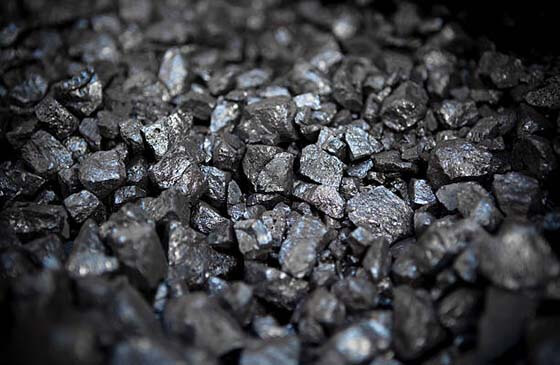
(Iron Ore)
Common iron ores that worth to be beneficiated are magnetite, hematite, magnetite- hematite (siderite), limonite, siderite, composite iron ore, and the like.
Iron ore beneficiation methods can be divided into two categories: single and combined.
The single method mainly includes magnetic separation (weak magnetic separation, strong magnetic separation), magnetization roasting magnetic separation, gravity separation, flotation separation and electric separation.
The joint method is divided into series and parallel according to the different connection methods of various methods. The former is used in series with different methods to recover different useful components; the latter is used in parallel with different methods to treat different grades of ore materials respectively.
Below we will introduce the beneficiation methods and process flows of five different iron ores- magnetite, hematite, magnetite- hematite (siderite), limonite and siderite.
01 Magnetite Beneficiation Method and Process Flow
BackMagnetite is mainly sedimentary metamorphic magnetite. Most of the iron minerals in the ore are magnetite, mainly fine grains; the gangue minerals are mainly silicate minerals such as quartz or amphibole, and some contain much iron silicate.
Since magnetite is a strong magnetic mineral, high-grade and high-recovery iron concentrate can be obtained by using weak magnetic separation. Many large and medium-sized magnetic separation plants often use a one-stage grinding magnetic separation process when the grinding particle size is greater than 0.2 ~ 0.3mm; when it is less than 0.2 ~ 0.3mm, a two-stage grinding magnetic separation process is used.
If the rough grinding can separate qualified tailings, the stage grinding magnetic separation process is adopted. If a certain amount of single gangue minerals are produced when mixed with a certain surrounding rock during mining or when crushed, a dry magnetic separator should be used for pre-separation before grinding.
For some ores, in order to obtain high-grade iron concentrate with iron grade of 66% to 68%, fine screen, magnetic separation column, reverse flotation and other methods can be used.
We have an article named 6 Common Magnetic Separation Equipment for Magnetite Separation, please click the link to check it.
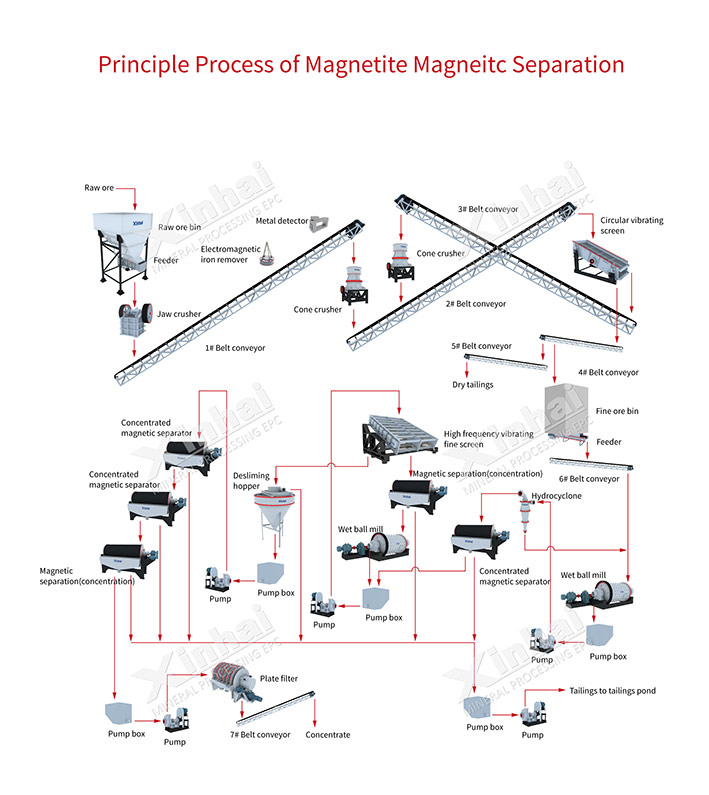
(Magnetite Separation Flow)
02 Hematite Beneficiation Method and Process Flow
BackHematite ore is a weak magnetic iron ore, and many beneficiation methods can be used, including gravity separation, flotation, strong magnetic separation, roasting magnetic separation and the combined process of several methods.
In recent years, combined processes with both parallel and series combinations have been widely used. For example, the lean hematite ore in a certain area adopts the combined process of gravity separation, magnetic separation and flotation to obtain a high index of iron ore concentrate of 65% to 67%.
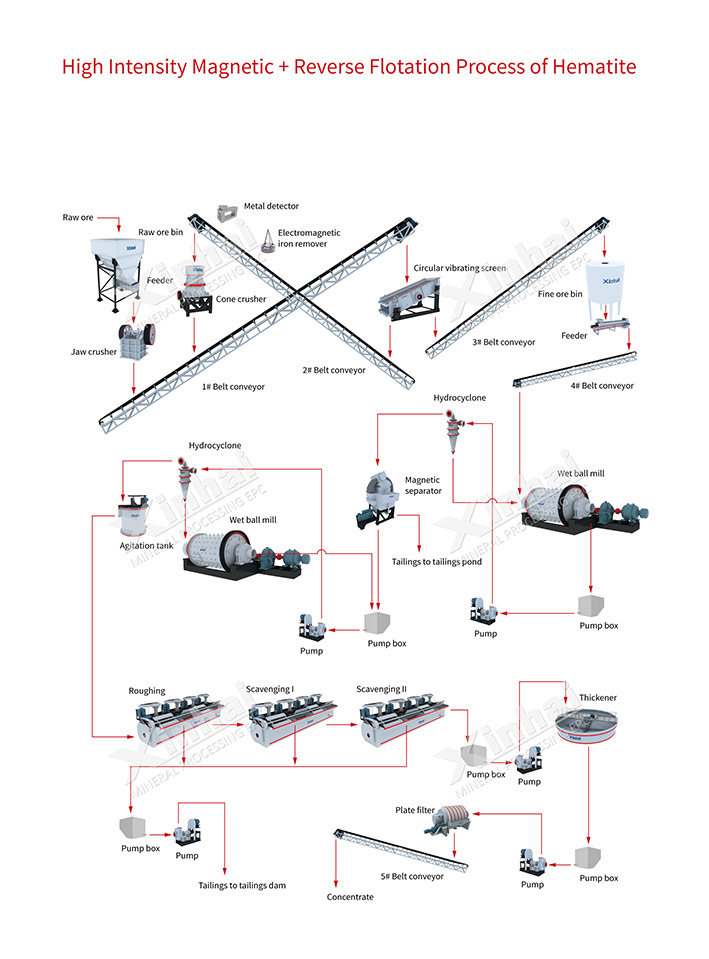
(Hematite Separation Flow)
1) Single Hematite Ore
Single hematite ores include hematite, siderite, limonite and hematite (specularite)-siderite from sedimentary metamorphic, sedimentary, hydrothermal and weathered deposits. There are two commonly used beneficiation methods.
Magnetization Roasting Magnetic Separation
Magnetization roasting magnetic separation is one of the effective methods to separate fine-grained to particulate (<0.02mm) hematite. When the mineral composition is complex, and other beneficiation methods are difficult to obtain good separation indicators, the magnetization roasting magnetic separation method is often used.
The shaft furnace reduction roasting process for 75 ~ 20mm lump ore is mature and has long-term production practice experience, while the 20 ~ 0mm rotary kiln magnetization roasting production practice is less. For powder ore, methods such as strong magnetic separation, gravity separation, flotation and their combined processes are commonly used for separation.
Gravity Separation, Flotation, Strong Magnetic Separation and Their Combined Processes
Flotation is one of the common methods for separating fine-grained to particulate hematite ore. It is divided into positive flotation and reverse flotation, and both have practical experience in production. Gravity separation and strong magnetic separation are mainly used to separate coarse grain (20 ~ 2mm) and medium grain hematite ore. Due to the great development of technology in recent years, it has been widely used to beneficiate fine-grained hematite ore.
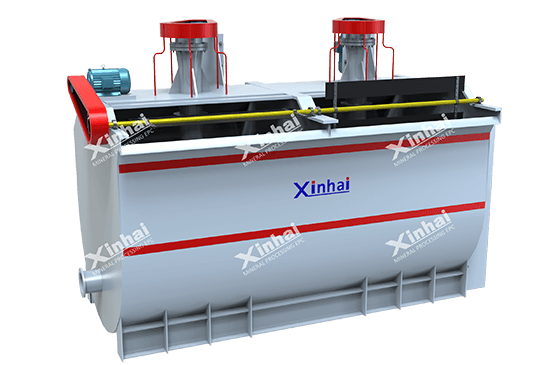
(Flotation Machine)
For the gravity separation of massive (>20mm) and coarse-grained ores, heavy medium or jig beneficiation methods are commonly used; for the gravity separation of medium and fine-grained ores, flow-film beneficiation methods such as spiral concentrators, shaking tables and centrifugal concentrators are used.
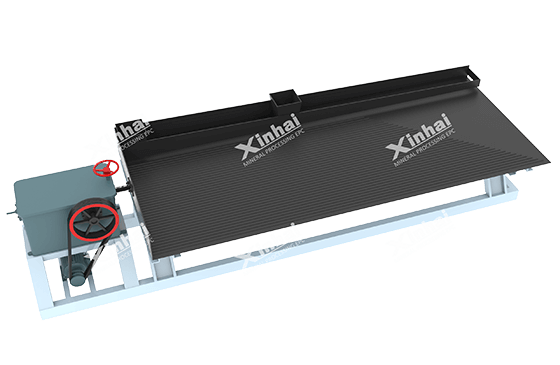
(Shaking Table)
Induction roller type magnetic separator is commonly used in the high magnetic separation of coarse and medium-grained ores, and wet induction medium vertical ring, flat-ring magnetic separator and pulsating high gradient magnetic separator are commonly used in the high-intensity magnetic separation of fine-grained ores.
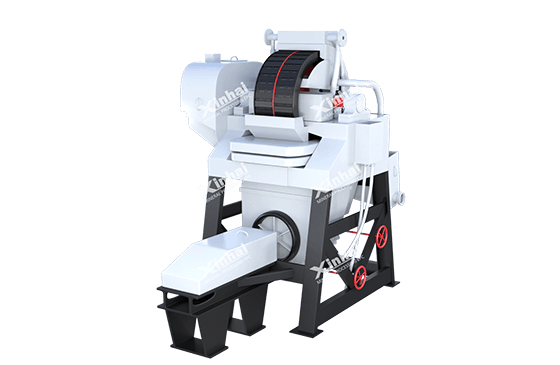
(Vertical Ring Pulsating High Gradient Magnetic Separator)
At present, due to the low grade of strong magnetic concentrate of fine-grained ores and the low processing capacity of gravity separation, a combined process of strong magnetic separation - gravity separation and strong magnetic separation - flotation is often used. We use strong magnetic separation to discard a large number of qualified tailings and gravity and flotation process to further process the strong magnetic concentrate to further improve the iron grade.
2) Polymetallic Hematite Ore
It is mainly hydrothermal and sedimentary phosphorus- or sulfide-containing hematite and siderite. Such ores generally use gravity separation, flotation, strong magnetic separation or other combined processes to recover iron ore, and use flotation to recover phosphorus or sulfide.
Hydrothermal apatite-bearing hematite ore and copper- and sulfide-bearing siderite ore can be processed by flotation.
Sedimentary phosphorus-containing oolitic hematite has phosphorus in the state of collophoane. Although it can be separated from iron minerals by flotation, it is often difficult to enrich into phosphorus concentrates, which greatly reduces the iron recovery rate.
For the development of sedimentary phosphorus-containing hematite ore, it is possible to consider the use of gravity separation or magnetic separation to pre-separate the ore with coarse grains, remove large-grained surrounding rocks, and restore the geological grade of the ore. Then fully sinter it into the furnace for smelting to produce high-phosphorus pig iron, and then use converter to make steel, and at the same time produce steel slag phosphate fertilizer.
The advantage of this method is that the beneficiation method is simple, the complicated processes of fine grinding and deep beneficiation for phosphorus reduction, silicon removal and aluminum removal are avoided, and the self-melting property of the ore is maintained, so that the phosphorus can be fully utilized.
03 Magnetite-Hematite (Siderite) Beneficiation Method and Process Flow
Back1) Single Magnetite- Hematite (Siderite) Ore
It is mainly sedimentary metamorphic magnetite and magnetite-siderite. The iron minerals in the ore are magnetite and hematite or siderite, mostly fine grains; the gangue minerals are mainly quartz, and some contain more iron silicate. The proportion of magnetite in the ore varies, often increasing gradually from the surface of the deposit to the depths.
There are two commonly used beneficiation methods for such ores:
Combined Process of Weak Magnetic Separation, Gravity Separation, Flotation and Strong Magnetic Separation
The combined process of recovering magnetite by weak magnetic separation and recovery weak magnetic iron minerals by gravity separation, flotation or strong magnetic separation has been used more in recent years. This is because the recovery of magnetite by weak magnetic separation is far more cost-effective than other beneficiation methods. At the same time, with the extension of service life in most mines, the processing plant will gradually change from processing magnetite-hematite ore to processing single magnetite ore.
The combined processes that have been adopted are: weak magnetic separation - flotation, flotation - weak magnetic separation, weak magnetic separation – gravity separation, weak magnetic separation - strong magnetic separation and weak magnetic separation - strong magnetic separation - gravity separation - flotation and so on.
In recent years, combined processes such as flotation - weak magnetic separation, weak magnetic separation - strong magnetic separation, weak magnetic separation - strong magnetic separation - gravity separation or weak magnetic separation - strong magnetic separation - flotation, weak magnetic separation - strong magnetic separation - gravity separation-flotation are popular.
Combined Process of Magnetization Roasting Magnetic Separation Method or Other Beneficiation Methods
The magnetization roasting magnetic separation process is similar to the magnetization roasting magnetic separation process of a single hematite ore, but in the parallel process with other beneficiation methods, the powder ore is treated by weak magnetic separation combined with other beneficiation methods.
In addition, there is also a series process of roasting magnetic separation and other beneficiation methods, that is, roasting and magnetic separation concentrates are beneficiated by flotation or gravity separation to further improve the concentrate grade. Magnetite-hematite ore with embedded fine particles is difficult to obtain good results with general beneficiation methods and methods such as selective flocculation desliming, flocculation flotation, flocculation strong magnetic separation and flocculation gravity separation should be used.
2) Polymetallic Magnetite-Hematite (Siderite) Ore
The ores included in this category are skarn-type sulfide-containing mixed iron ore and hydrothermal-type mixed iron ore containing phosphorus, sulfur or rare earth.
The beneficiation method of this type of ore is the most complicated in iron ore. Generally, the combined process of weak magnetic separation and other beneficiation methods is used, that is, weak magnetic separation is used to recover magnetite; gravity separation, flotation or strong magnetic separation is used to recover weak magnetic hematite (siderite) ore; flotation is used to recover associated components.
The process includes: weak magnetic separation - flotation - strong magnetic separation, weak magnetic separation - strong magnetic separation - flotation and weak magnetic separation - reelection - flotation, etc.
For mixed iron ore containing rare earth, if the iron minerals are mainly hematite, reduction roasting magnetic separation-flotation process is also used, that is, reduction roasting is used to recover hematite minerals, and flotation is used to recover rare earth minerals. Flotation of rare earth minerals after reduction roasting is beneficial to improve the beneficiation index. In addition, the flotation-selective flocculation process can also obtain high indicators.
04 Limonite Beneficiation Method and Process Flow
BackLimonite is 2Fe2O3•3H2O. Because it is rich in crystal water, it is difficult to reach 60% iron grade by physical beneficiation. In addition, it is difficult to obtain a high metal recovery rate because limonite is easily burning reduced during the grinding process.
The Tiekeng limonite deposit is a pyrite skarn-type iron-cap limonite deposit. There are two types of ore industry: skarn-type limonite and high-silica-type limonite. The former accounts for 66%, and the ore is composed of limonite, hematite and quartz, and the latter ore is composed of limonite, goethite and hematite.
The beneficiation method includes the combined process of magnetization roasting-weak magnetic separation, gravity separation, strong magnetic separation, flotation, selective flocculation and flotation, strong magnetic separation-positive flotation-strong magnetic separation, strong magnetic separation-reverse flotation process, etc.
We have an article introduces How to Extract Iron from Limonite in details, click the link to check it.
05 Siderite Beneficiation Method and Process Flow
BackThe theoretical grade of siderite is low, only 48.2%, and it is often symbiotic with calcium, magnesium, and manganese. Therefore, it is difficult for physical beneficiation methods to make the grade of iron concentrate over 45%, but using roasting can greatly improve the grade of iron concentrate.
Due to the characteristics of siderite, it is a promising iron ore resource. First, it can improve the iron grade after roasting. For example, when the iron grade is 35%, after roasting at 600~700℃, the iron grade can reach 50%. Second, the siderite is transformed into magnetite after roasting, which is easy for magnetic separation. The third is that siderite has good reducibility. After roasting, CO2 escapes from the ore, which increases the voids in the ore, thereby increasing the contact area with the reducing gas, which is beneficial to smelting.
Siderite beneficiation methods include gravity separation, strong magnetic separation, strong magnetic separation, flotation, magnetization, roasting, and weak magnetic separation.
06To Wrap Up
BackThe above is the beneficiation process and process of the 5 kinds of iron ore. If you need the relevant beneficiation process and equipment, or have any questions, please consult the online customer service, or leave a message on the website for consultation.
Besides, we have an article of Ultimate Guide for Magnetic Separation Method, please click the link to check it.
 +86 183 3575 8886
+86 183 3575 8886 pinklaurabao@gmail.com
pinklaurabao@gmail.com




 Message
Message Chat Now
Chat Now


